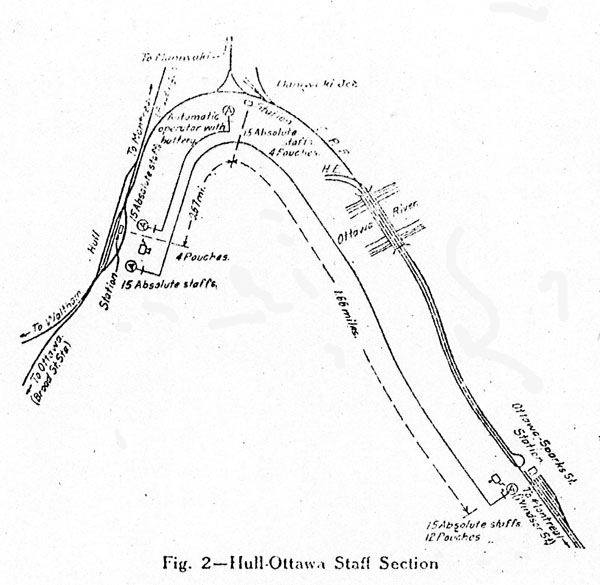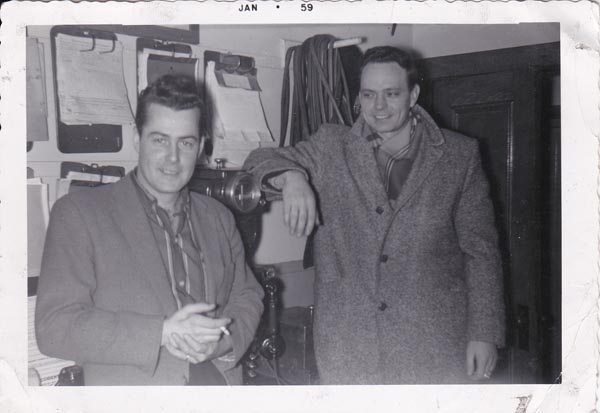The Railways of Ottawa
Findings of the Circle
|
Finding
No. 26
ELECTRIC TRAIN STAFF ON THE CANADIAN PACIFICThe Canadian Pacific has in service a number of installations of electric train staff on single-track sections where traffic is heavy, notably on the Lake Superior division, which is not completely double-tracked and where the staff system was installed on all single-track portions in order to eliminate the delays and inconveniences due to the use of train orders. On other sections, for the purpose of providing for certain Junctions and intermediate sidings, several modifications have been devised.  The staff instruments are type S miniature instruments, made by the Railway Signal Company, of Liverpool, England. Metallic circuits are used, and to prevent the possibility of a careless maintainer reversing the polarity, current for the operation of the instruments is furnished by magneto-generators equipped with two tapper keys, so that one magneto provides current for the block on either side of the station. These keys are mechanically interlocked to prevent the current from being sent in both directions at the same time. Each instrument is equipped with an indicator showing "staff out; line blocked", when a staff has been withdrawn from either instrument, and "staff in; line clear" when no staff is out. The train staffs are made in such a manner that it is impossible for the staff belonging to one block to be inserted in the instrument of an adjoining block. Permissive movements are made by means of a staff which is divisible into two parts. These parts must be screwed together before the staff can be replaced in the instrument. The capacity of each instrument is 40 staffs, and at stations where the permissive feature is used, 20 of these are divisible, Each station has a telephone, which is worked over the staff line wire. On staff sections where there are there are few train movements at night, an "automatic operator" has been installed. A stick relay, the armature of which is balanced and on which there is one normally closed contact, and one normally open contact, the other members of these contacts being on pivoted weights, provides the automatic feature. When the relay is energized the armature is rotated in a direction to cause it to lift the weight on which the normally closed contact is fixed, and when current is broken, the weight causes the armature to rotate in the opposite direction a sufficient distance to close the other contact and cut in a local battery which energizes a coil to release the staff at the opposite end of the block. It is possible to operate a staff block without an operator at either station, by using this attachment at both ends.  In a staff block between Hull and Sparks Street station, Ottawa, it was necessary to install an auxiliary pair of instruments at Maniwaki Junction on account of a branch line connecting at that point. The four instruments are alike and a staff from one may be deposited in any other; and a train obtaining a staff for this block may move between any two of the instruments. When all staffs are in the instruments one or the other of the two pairs of instruments is out of phase, and a staff can be obtained only from the pair which is in phase. Thus when a train starts from one block instrument, having taken a staff out of the only pair which is in phase, this throws the remaining pair of instruments out of phase at the opposite end of the block so that no staff can be obtained at that end. This arrangement could be used with a greater number of auxiliary pairs. Prepared by D.H.I. Thomas from the article by E.S. Tay1or (Ass't. Signal Eng’r., C.P.R., Montreal in Railway Age Gazette, v 58, Jan, 15, 1915, p 100 –101. The author's use of the present tense has been retained. Summary of the Electric Staff systems installed in the Ottawa-Hull Area (from notes provided by Bruce Chapman) 24 April 1912 - Electric staff system installed between Ottawa, (Sparks Street), Hull and Ottawa West, (Broad Street) By 24 June 1917 - the system was extended (1) from Hurdman to Ottawa (Broad Street) including Grand Trunk junction/Deep Cut. (2) a permissive staff system was in operation between Ottawa (Broad Street) and Chaudiere (Ellwood) By 5 January 1927 the permissive staff system was gone from Ottawa Broad Street to Chaudiere (Ellwood) By 1 May 1927 the staff system was taken out from Ellwood to Hurdman By 10 January 1933 the system from Hurdman to CN Junction (Grand Trunk Junction) was gone. 31 July 1966 - The original staff system between Ottawa, (Sparks Street), Hull and Ottawa West, (Broad Street) was taken out of use with the closure of the Union station and the line across the Alexandra bridge abandoned.  The Ottawa West staff machine in 1959; the late Paul Weaner on the left, Keith McCann, now age 87 on the right |
![]()
Updated 12 May 2019